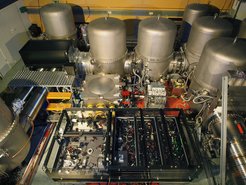German Research Foundation supports new collaborative research center TerraQ
The Institute for Gravitational Physics at Leibniz University Hannover will do research on and improve interferometric precision measurements and laser links between satellites
The collaborative research center (Sonderforschungsbereich / SFB) “Relativistic and Quantum-Based Geodesy (TerraQ)”, funded by the German Research Foundation (Deutsche Forschungsgemeinschaft / DFG), investigates novel methods of geodesy using fundamentally new sensors, measurement techniques, analysis methods and modeling approaches. Researchers of the Institute for Gravitational Physics at Leibniz Universität Hannover contribute their decades of experience and their worldwide leading role in the field of interferometric precision measurements and laser links between satellites. Basic research is thereby used in climate research and improves the precious data at its foundation.

In TerraQ, latest results from quantum and gravitational physics will contribute to significantly increasing the accuracy of geodetic measurements, i.e. the surveying of our home planet.
“The methods we have developed for gravitational physics from basic research are already finding practical applications in climate research. They allow us to monitor the melting of polar ice caps and glaciers even more precisely," says Karsten Danzmann, director of the Institute for Gravitational Physics and designated deputy spokesperson of TerraQ. “With the newly founded collaborative research center TerraQ we can further deepen our expertise and experience in working together with outstanding colleagues.”
During the first four-year funding period of TerraQ, six PhD positions will be established at the Institute for Gravitational Physics. During this period, the DFG will also provide research funding; for the SFB as a whole, approximately 9.6 million Euros will be available until 2024.
A leading role in gravitational-wave research

Researchers at the institute play a leading role in worldwide gravitational-wave research and the development and operation of the detectors. The detectors measure the effects of Einstein's gravitational waves with high-precision lasers. New methods and technologies have been developed at the Institute for Gravitational Physics and the Max Planck Institute for Gravitational Physics in Hannover and at the gravitational-wave detector GEO600. They enabled the LIGO detectors in September 2015 to make the first direct detection of gravitational waves which were predicted by Einstein in 1916. Since then, the worldwide detector network has observed the gravitational waves from colliding black holes and neutron stars 50 times, thus establishing a whole new field of astronomy.
The scientists are also involved in the next generation of gravitational-wave observatories on Earth; they are developing the Einstein Telescope with European partners. With this detector of the third – even more sensitive – generation, gravitational-wave astronomy is to enter a new age.
Monitoring climate indicators with satellites in Earth orbit

How can the distance between satellites orbiting the Earth be measured more accurately than ever before using a laser link? And how can we use it to monitor the Earth's gravitational field and indicators of climate change such as melting polar ice caps and glaciers even more precisely? Scientists at the institutes have answered these questions with their laser interferometer on board the satellite tandem GRACE Follow-On. The very successful mission was launched in May 2018 and has proven its reliability, perfect performance, and high measurement accuracy in continuous operation since it was first switched on in July 2018.
The measurement principle tested with GRACE Follow-On is considered a promising candidate for many similar follow-up missions and is a milestone on the way to LISA, the gravitational wave observatory in space. LISA is currently being prepared for the planned launch in 2034 under the leadership of researchers from both institutes together with the European Space Agency.
TerraQ
In addition to the Institute for Gravitational Physics, researchers involved in TerraQ are at the Institute for Quantum Optics and the Institute for Geodesy at Leibniz Universität Hannover, the DLR Institute of Satellite Geodesy and Inertial Sensor Technology Hannover, the Physikalisch Technische Bundesanstalt Braunschweig, the Center of Applied Space Technology and Microgravity Bremen, the GeoForschungsZentrum Potsdam, HafenCity University Hamburg and Graz University of Technology. The SFB will start its work on January 1, 2021 and is initially funded for a period of 4 years. In case of a positive evaluation, the funding can be extended up to 12 years. Designated spokesperson of the SFB is Jürgen Müller from the Institute of Geodesy at Leibniz Universität Hannover.
Further information in the Leibniz University press release.














